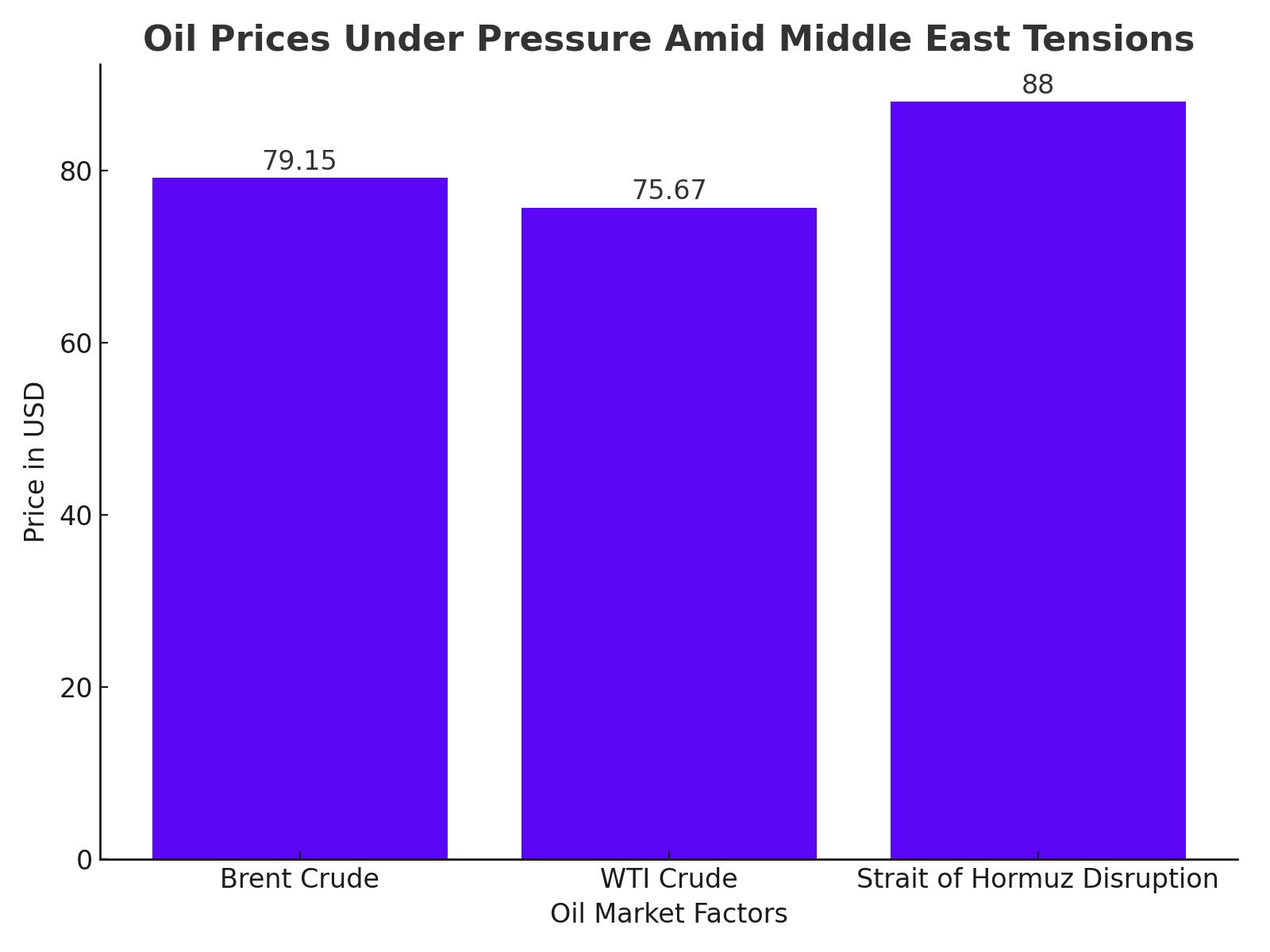
Oil Prices Soar Amid Threats to Key Supply Routes from Middle East Conflict
Escalating Geopolitical Tensions Ignite Fears of Major Supply Disruptions, Sending Oil Markets into a Frenzy | That's TradingNEWS
Oil Prices Under Pressure Amid Middle East Tensions and Supply Concerns
Geopolitical Instability Fuels Oil Market Volatility
Crude oil prices have been on a volatile journey, driven by increasing tension in the Middle East and concerns about supply security. As of late, both Brent crude and WTI crude are showing gains, with Brent hovering near $80 per barrel and WTI crossing $75. These gains are rooted in growing fears that the ongoing conflict between Israel and Iran could disrupt global oil supplies, particularly through the Strait of Hormuz, one of the world’s most critical oil transit points.
The Strait of Hormuz, through which around 21% of the world’s oil passes, has long been a flashpoint for geopolitical risk. A major disruption here could send prices skyrocketing, with potential spikes reaching unprecedented levels. Analysts are warning that should Israel target Iranian oil infrastructure, as has been speculated, Iran could retaliate by threatening oil installations in Gulf states or obstructing the strait.

Gulf States’ Plea to Washington: Mitigating the Fallout
In a bid to mitigate the potential fallout, Gulf states have been actively lobbying Washington to convince Israel to avoid targeting Iranian oil facilities. This diplomatic move stems from concerns that such a strike would provoke retaliatory attacks by Iran-backed factions on oil infrastructure in Saudi Arabia, the United Arab Emirates, and other key oil producers in the region. Iran has already signaled that any such attack would be perceived as an act of war, which could ignite a broader conflict that would undoubtedly rattle global oil markets.
The possible closure of the Strait of Hormuz would cut off a significant portion of global oil supplies, driving prices well above current levels. With over 14 million barrels per day passing through the strait, any interruption could lead to substantial upward price pressure, compounded by the fact that only Saudi Arabia and the UAE have operational pipelines capable of bypassing the strait—providing an insufficient alternative.
Hurricane Milton's Impact on U.S. Oil Supply
Adding to the uncertainty is Hurricane Milton, which recently made landfall in Florida. Though the hurricane weakened before hitting the coast, its potential to disrupt fuel supplies in the United States briefly pushed oil prices higher. Florida saw roughly 25% of its gasoline stations run out of fuel during the storm, temporarily boosting demand for crude oil in the region. However, as the storm's impact subsides, attention has quickly returned to the geopolitical risks centered around the Middle East.
OPEC’s Strategic Positioning and Global Supply Outlook
OPEC's ability to navigate these volatile market conditions remains crucial. With output decisions under constant scrutiny, OPEC members are poised to respond to any significant disruptions in supply. Saudi Arabia, in particular, plays a vital role as one of the few producers with spare capacity to adjust output in response to global shortages. Despite the bullish outlook, Saudi Arabia and other producers have made it clear that they are not actively taking sides in the conflict, a stance that could change depending on how the situation escalates.
U.S. President Joe Biden has also cautioned Israel against striking Iranian oil sites, given the potential for these actions to destabilize the global energy market further. With tensions between Tehran and Tel Aviv continuing to rise, the risk of a broader war involving oil supply remains at the forefront of market concerns.
Market Reaction: Price Spikes and Investor Sentiment
The initial price reaction has been sharp, with oil markets rallying more than 9% since the start of hostilities between Israel and Iran. Investors are increasingly betting on rising oil prices, particularly as the geopolitical situation shows no signs of calming. The risk of an energy supply shock remains real, as even minor disruptions in the region have historically had outsized effects on global prices.
A conflict in the Middle East could have a long-term impact on the oil supply chain, leading to higher costs and heightened volatility in energy markets. While Western consumers may see price hikes at the pump, the U.S.’s rise as a leading oil producer in recent years has somewhat insulated the country from catastrophic price spikes. However, the knock-on effects for China—which imports a significant portion of its oil from Iran—could be much more pronounced, with potential supply shortages leading to inflation in Chinese goods exported globally.
Oil Futures and Market Speculation
The futures market has reacted with increased volatility. WTI futures surged by 2.51% to $75.67 per barrel, while Brent crude futures climbed 2.58% to $79.15 per barrel. These futures movements reflect both immediate supply concerns and longer-term expectations of tighter oil markets if the conflict continues to escalate.
Furthermore, investor focus has shifted to U.S. crude inventories, which showed a build-up of 3.89 million barrels in the latest EIA data. This supply build has tempered some of the immediate bullishness in the market, but concerns remain about potential disruptions from both the Middle East and domestic U.S. supply issues caused by Hurricane Milton.
Historical Precedents: Energy Price Hikes and Economic Impact
The potential for a major price surge mirrors historical energy shocks, such as the Arab oil embargo in 1973 and the Iranian Revolution in 1979, which led to sharp increases in oil prices and global economic disruption. However, the global economy has evolved, and the increasing reliance on renewable energy sources and domestic oil production has made the world less vulnerable to oil shocks than in previous decades.
Still, any major supply interruption from the Middle East could have significant repercussions, particularly in regions like Europe and Asia, where reliance on Middle Eastern oil remains high. The recent price volatility serves as a reminder that despite efforts to transition to alternative energy sources, the global economy is still deeply intertwined with the health and stability of the oil market.
Outlook: Will Oil Prices Hold?
As the world watches the unfolding situation in the Middle East, oil prices are expected to remain highly volatile. Any significant escalation, such as a closure of the Strait of Hormuz or direct attacks on Gulf oil facilities, could push prices toward new highs. On the other hand, if diplomatic efforts succeed in keeping the conflict contained, oil prices may stabilize, though the current geopolitical climate suggests that further volatility is likely in the near term.
In the longer term, the global oil market faces structural shifts, with growing investments in renewable energy and green technologies gradually reducing dependence on fossil fuels. However, until these technologies reach mass adoption, geopolitical tensions in key oil-producing regions will continue to drive price fluctuations, keeping oil a focal point for investors and policymakers alike.
Is It Time to Buy or Hold Oil Stocks?
For investors, the current environment presents both risks and opportunities. The potential for a supply shock from the Middle East offers a strong upside for oil stocks, especially as prices rise in response to geopolitical instability. However, the situation remains fluid, and those looking to invest in oil must weigh the short-term volatility against the potential for longer-term price stabilization.
Investors should monitor developments closely, especially surrounding key supply points like the Strait of Hormuz. Given the current outlook, oil stocks appear to be a buy for those willing to navigate the risks associated with geopolitical tensions, though caution is warranted due to the high levels of uncertainty.
That's TradingNEWS
Read More
-
BITQ ETF Soars 66.55% as Bitcoin Blasts Past $124,000 — Crypto Equities Lead 2025 Rally
13.10.2025 · TradingNEWS ArchiveStocks
-
XRP ETFs XRPR, XRPI Slip as Ripple XRP-USD Holds $2.62 — SEC Fast-Track Could Ignite $20B
13.10.2025 · TradingNEWS ArchiveCrypto
-
Natural Gas Price Forecast - NG=F Steadies at $3.00 as U.S. Export Boom Tests Old Fields
13.10.2025 · TradingNEWS ArchiveCommodities
-
USD/JPY Price Forecast - Dollar to Yen Climbs to ¥152.28 as Japan’s Political Shakeup
13.10.2025 · TradingNEWS ArchiveForex



















